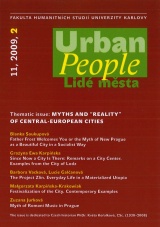Myths and “Reality” of Central-European Cities during the Formation of Identities
DOI:
https://doi.org/10.14712/12128112.3654Abstrakt
One of the accompanying features of the modernization of society is its urbanization (HOHENBERG – HOLLEN LEES 1985). Anthony Giddens (1999: 445) characterized it as a global process. Urban ethnography (later also anthropology), developed in Czechoslovakia and Poland at the end of the 1970s and beginning of the 1980s, paid attention until then to partial problems in the development of cities and the lifestyles of their inhabitants. Numerous microanalyses concerning the city in a certain period also corresponded to it, mainly in the time from the 19th and 20th centuries. Various aspects of material culture (e.g., inhabitants’ ways of dressing, eating, and living) were also studied. In the case of spiritual culture, attention concentrated on urban celebrations and entertainment, exhibitions, folklore, urban educational, theatrical, corporative and family systems. Ethnographers and anthropologists, like historians and sociologists, also studied the lifestyles of the inhabitants of the city (e.g., lifestyles of workers, ethnic minorities, women, marginalized groups [prostitutes, beggars], workers’ and Jewish families, the middle class). In the last decade research has also begun on meeting places in cities as well as urban non-places, research of functions of individual parts of the city, impact of modernization on the mentality of the people. Current urban anthropology is further characterized by research of individual elements of the identity of a city, the quality of urban dialogues, in Czech anthropology mainly ethnic, research of sacral and profane places in the city, specific natural formations, monuments of individual groups of ethnic and national minorities. One monument can exist at the same time in the discourse of several nations and minorities. Inclination toward the contemporary city prevails. Productivity of the indicator of myths in cultural activities of European cities was demonstrated last year in two conferences: those in Krakow and Prague (Evropské město: obraz, stereotyp, mýtus. Co lze mýtizovat ve městě? [European city: image, stereotype, myth. What can be mythicized in a city?]). Through a flood of articles, studies and books anthropologists in recent times have arrived at a comparative view of the city.
Stahování
Publikováno
Jak citovat
Číslo
Sekce
Licence

Tato práce je licencována pod Mezinárodní licencí Creative Commons Attribution-NonCommercial-NoDerivatives 4.0.


